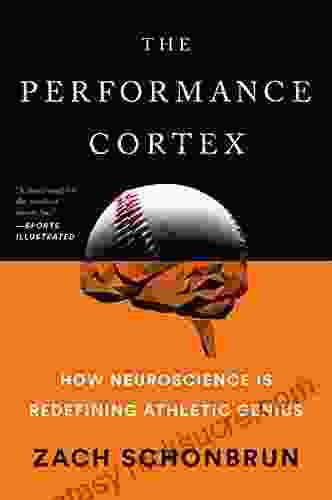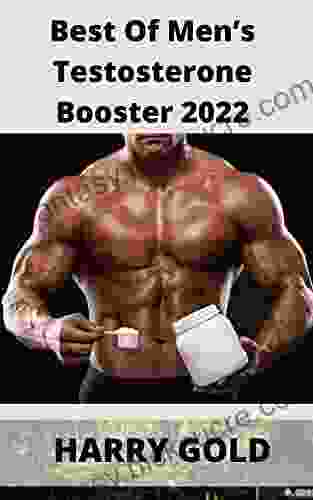How Neuroscience Is Redefining Athletic Genius

4.4 out of 5
| Language | : | English |
| File size | : | 5731 KB |
| Text-to-Speech | : | Enabled |
| Screen Reader | : | Supported |
| Enhanced typesetting | : | Enabled |
| X-Ray | : | Enabled |
| Word Wise | : | Enabled |
| Print length | : | 351 pages |
For centuries, we've marveled at the superhuman feats of athletic geniuses like Usain Bolt, Michael Jordan, and Serena Williams. But what makes these athletes so special? Is it simply a matter of genetics, or is there something more to it?
Neuroscience is a relatively new field, but it's already providing groundbreaking insights into the minds of athletic geniuses. By studying the brains of these elite athletes, scientists are learning more about how they process information, control their movements, and stay motivated. And this knowledge is not only helping us to understand what makes these athletes so great, but it's also helping us to develop new training methods that can help all athletes improve their performance.
The Brain of an Athletic Genius
The brains of athletic geniuses are different from the brains of ordinary people in a number of ways. For example, they have larger volumes of gray matter in areas of the brain that are involved in motor control, coordination, and decision-making. They also have more white matter, which is the tissue that connects different parts of the brain. This increased connectivity allows for faster and more efficient communication between different brain regions.
In addition to these structural differences, the brains of athletic geniuses also show different patterns of activity during exercise. For example, they have increased activity in the prefrontal cortex, which is the part of the brain that is responsible for planning, decision-making, and self-control. They also have decreased activity in the amygdala, which is the part of the brain that is responsible for fear and anxiety.
These differences in brain structure and activity give athletic geniuses a number of advantages over ordinary athletes. They are able to learn new movements more quickly, they can make better decisions under pressure, and they can stay focused and motivated even when they are exhausted.
The Role of Genetics
Genetics play a role in athletic performance, but they are not the only factor. In fact, studies have shown that environmental factors, such as training and nutrition, can have a significant impact on athletic performance. However, genetics can give athletes a head start by providing them with certain physical advantages, such as greater muscle mass, faster reflexes, and a higher aerobic capacity.
For example, a study by the University of Sydney found that elite sprinters had a genetic variant that allowed them to produce more of a protein called alpha-actinin-3. This protein helps to regulate muscle contraction, and it is essential for speed and power.
Another study by the University of Copenhagen found that elite endurance athletes had a genetic variant that allowed them to produce more of a protein called peroxisome proliferator-activated receptor gamma coactivator 1-alpha (PGC-1alpha). This protein helps to regulate mitochondrial function, and it is essential for endurance performance.
These are just two examples of how genetics can influence athletic performance. However, it is important to remember that genetics are not destiny. Even athletes with the most advantageous genes need to put in the hard work to reach their full potential.
The Role of Training
Training is essential for athletic success. It is through training that athletes develop the physical and mental skills that they need to compete at the highest level. However, not all training is created equal. Some types of training are more effective than others for improving athletic performance. For example, research has shown that high-intensity interval training (HIIT) is a very effective way to improve cardiovascular fitness, muscular strength, and power.
HIIT involves alternating between short bursts of high-intensity exercise with periods of rest or low-intensity exercise. This type of training is very challenging, but it is also very effective. Studies have shown that HIIT can improve VO2 max (a measure of cardiovascular fitness) by up to 20% in just a few weeks.
In addition to HIIT, other types of training that have been shown to be effective for improving athletic performance include strength training, plyometrics, and flexibility training. Strength training helps to build muscle mass and strength, plyometrics helps to improve power and explosiveness, and flexibility training helps to prevent injuries and improve range of motion.
The Role of Environment
The environment also plays a role in athletic performance. This includes factors such as altitude, temperature, humidity, and pollution. For example, research has shown that athletes who train at high altitudes tend to have higher levels of red blood cells, which can help to improve endurance performance. Athletes who train in hot and humid environments also tend to have higher levels of sweat production, which can help to prevent dehydration and heat exhaustion.
In addition to these environmental factors, social and cultural factors can also influence athletic performance. For example, athletes who have access to good coaching, nutrition, and training facilities are more likely to succeed than athletes who do not. Athletes who come from supportive families and communities are also more likely to achieve their full potential.
The Future of Athletic Performance
Neuroscience is providing new insights into the minds of athletic geniuses, and this knowledge is helping us to develop new training methods that can help all athletes improve their performance. As our understanding of the brain continues to grow, we can expect to see even more breakthroughs in athletic performance in the years to come.
Here are some of the future trends that we can expect to see in athletic performance:
- Increased use of technology: Technology is already playing a big role in athletic performance, and this trend is only going to continue in the future. Athletes are using technology to track their progress, analyze their performance, and develop new training methods.
- Personalized training: As we learn more about the individual differences between athletes, we will be able to develop more personalized training programs. These programs will be tailored to each athlete's unique needs and goals.
- Improved recovery methods: Recovery is just as important as training, and athletes are always looking for new ways to improve their recovery. In the future, we can expect to see new advances in recovery methods, such as cryotherapy, massage therapy, and nutritional supplements.
The future of athletic performance is bright. As neuroscience continues to provide new insights into the minds of athletic geniuses, we can expect to see even more breakthroughs in athletic performance in the years to come.
4.4 out of 5
| Language | : | English |
| File size | : | 5731 KB |
| Text-to-Speech | : | Enabled |
| Screen Reader | : | Supported |
| Enhanced typesetting | : | Enabled |
| X-Ray | : | Enabled |
| Word Wise | : | Enabled |
| Print length | : | 351 pages |
Do you want to contribute by writing guest posts on this blog?
Please contact us and send us a resume of previous articles that you have written.
 Fiction
Fiction Non Fiction
Non Fiction Romance
Romance Mystery
Mystery Thriller
Thriller SciFi
SciFi Fantasy
Fantasy Horror
Horror Biography
Biography Selfhelp
Selfhelp Business
Business History
History Classics
Classics Poetry
Poetry Childrens
Childrens Young Adult
Young Adult Educational
Educational Cooking
Cooking Travel
Travel Lifestyle
Lifestyle Spirituality
Spirituality Health
Health Fitness
Fitness Technology
Technology Science
Science Arts
Arts Crafts
Crafts DIY
DIY Gardening
Gardening Petcare
Petcare Bill Streever
Bill Streever Gary Nicol
Gary Nicol Jojo Siwa
Jojo Siwa Manoj Sharma
Manoj Sharma Doug Scott
Doug Scott Vanessa Lapointe
Vanessa Lapointe Robert F Burgess
Robert F Burgess Dave Pine
Dave Pine Colleen Graves
Colleen Graves Cheryl Marlene
Cheryl Marlene Izzy Judd
Izzy Judd Susan M Orsillo
Susan M Orsillo Supersummary
Supersummary S W Wilcox
S W Wilcox Bex Gunn
Bex Gunn Gwendoline Smith
Gwendoline Smith Jessica Taylor
Jessica Taylor Frank S Ring
Frank S Ring Holly Donahue Singh
Holly Donahue Singh Jacqueline B Persons
Jacqueline B Persons Frank Giampaolo
Frank Giampaolo Robert P Beebe
Robert P Beebe Donncha Hanna
Donncha Hanna Michael D Alessio
Michael D Alessio Kristin N Spencer
Kristin N Spencer Tim Weston
Tim Weston Paula Yoo
Paula Yoo Ofer Gal
Ofer Gal Rupert Spira
Rupert SpiraR E S
 Diana Wynne Jones
Diana Wynne Jones J D Gauchat
J D Gauchat Kevin C Kelleher Md Md
Kevin C Kelleher Md Md Joann Cianciulli
Joann Cianciulli Pete Spencer
Pete Spencer Martyn Denscombe
Martyn Denscombe Freddie Fernandez
Freddie Fernandez Sanford Holst
Sanford Holst Jitendra Chouksey
Jitendra Chouksey Marie Max House
Marie Max House Ginger Sinsabaugh
Ginger Sinsabaugh Sam Harris
Sam Harris Maggi Savin Baden
Maggi Savin Baden Eric A Weiss Md
Eric A Weiss Md Jeffrey Lindsey
Jeffrey Lindsey Tina Cassidy
Tina Cassidy Bill Patton
Bill Patton Tony Guerra
Tony Guerra Bill Karwin
Bill Karwin Rob Steger
Rob Steger Clement Salvadori
Clement Salvadori Gail Fay
Gail Fay Bob Glover
Bob Glover Sang H Kim
Sang H Kim Stephen L Morgan
Stephen L Morgan Paul Brummell
Paul Brummell Jarrett Dapier
Jarrett Dapier Fiona Danks
Fiona Danks Yakima Canutt
Yakima Canutt Bjorn Kiggen
Bjorn Kiggen Jacques Steinberg
Jacques Steinberg The Uk Mathematics Trust
The Uk Mathematics Trust Dick Edie
Dick Edie Brienne Murk
Brienne Murk Max Lugavere
Max Lugavere Simon Buxton
Simon Buxton Douglas W Ota
Douglas W Ota Brandon Sanderson
Brandon Sanderson Elizabeth Thompson
Elizabeth Thompson Silvia Dunn
Silvia Dunn Linda D Dahl
Linda D Dahl Mark Lehner
Mark Lehner Jeremy Paxman
Jeremy Paxman Matt Doeden
Matt Doeden James P Allen
James P Allen Curvebreakers
Curvebreakers P J E Peebles
P J E Peebles Michael Tlanusta Garrett
Michael Tlanusta Garrett Larry Baush
Larry Baush Sue L Hamilton
Sue L Hamilton Kristopher Martel
Kristopher Martel Jakub Marian
Jakub Marian Gregg Jackson
Gregg Jackson David E Johnson
David E Johnson William F Keegan
William F Keegan Sara Low
Sara Low Beck Weathers
Beck Weathers James R Payne
James R Payne Joy Hakim
Joy Hakim Henry M Cowles
Henry M Cowles James Alexander Currie
James Alexander Currie Carson Sievert
Carson Sievert Irene Mceachen
Irene Mceachen Bill Gladstone
Bill Gladstone Geraldine Van Bueren
Geraldine Van Bueren Isabel Fonseca
Isabel Fonseca Gianna Sobol
Gianna Sobol Brian Crist
Brian Crist Pat Drake
Pat Drake Cj Andersen
Cj Andersen Victoria Johnson
Victoria Johnson Rick Steves
Rick Steves Adiba Jaigirdar
Adiba Jaigirdar Charles Duhigg
Charles Duhigg Sara Dyer
Sara Dyer Mark Young
Mark Young Rod Powers
Rod Powers Elizabeth King
Elizabeth King Elizabeth A Stanley
Elizabeth A Stanley David Halberstam
David Halberstam Megan Don
Megan Don Suzannah Rowntree
Suzannah Rowntree Jen Castleberry
Jen Castleberry Jared Derksen
Jared Derksen Kat Kruger
Kat Kruger Jake Jacobson
Jake Jacobson Conway X Bowman
Conway X Bowman Eric H Cline
Eric H Cline T Edward Nickens
T Edward Nickens Ross Edgley
Ross Edgley Marcus Brotherton
Marcus Brotherton Bob Duchesne
Bob Duchesne Christopher Banecks
Christopher Banecks Virginia Smith Harvey
Virginia Smith Harvey Helen Clarke
Helen Clarke Vernon G Zunker
Vernon G Zunker Michael J Epstein
Michael J Epstein Chris Napier
Chris Napier Jamie Dumas
Jamie Dumas John Mccollister
John Mccollister Edwin H Friedman
Edwin H Friedman Jessica Denay
Jessica Denay Marc Bona
Marc Bona Michael Lempert
Michael Lempert Phoebe Bailey
Phoebe Bailey Richard Post
Richard Post Richard W Fisher
Richard W Fisher John Brierley
John Brierley James Patterson
James Patterson Richard Holmes
Richard Holmes Hugh Neill
Hugh Neill Mindy Mcginnis
Mindy Mcginnis Wendy Hinman
Wendy Hinman David Benjamin
David Benjamin Luciano Floridi
Luciano Floridi Olivia Gordon
Olivia Gordon David Joyce
David Joyce Yossi Ghinsberg
Yossi Ghinsberg Heather Long
Heather Long Dr Nancy L Nolan
Dr Nancy L Nolan Lucas Bessire
Lucas Bessire Jamie Foxx
Jamie Foxx Mark Vanhoenacker
Mark Vanhoenacker Paul Francis
Paul Francis Sandra Davidson
Sandra Davidson Erin Mcrae
Erin Mcrae Editors Of Sports Illustrated
Editors Of Sports Illustrated Wanza Leftwich
Wanza Leftwich Fred H Croom
Fred H Croom Pat Cohen
Pat Cohen Bryan Irwin
Bryan Irwin John Muir Laws
John Muir Laws Jelena Bogdanovic
Jelena Bogdanovic Melissa Layne
Melissa Layne Margo Armstrong
Margo Armstrong Zach Schonbrun
Zach Schonbrun Greg Witt
Greg Witt David Price
David Price Jennifer Kolari
Jennifer Kolari Paul Bellow
Paul Bellow Hayley Mitchell Haugen
Hayley Mitchell Haugen Kate Marchant
Kate Marchant Nicole R Taylor
Nicole R Taylor Curt Sampson
Curt Sampson Sue Enquist
Sue Enquist Peter Aitken
Peter Aitken James Dashner
James Dashner Zigzag English
Zigzag English Kent Hrbek
Kent Hrbek Jane Bottomley
Jane Bottomley Ellen Schuthof Lesmeister
Ellen Schuthof Lesmeister Andrea Cremer
Andrea Cremer Herschel Knapp
Herschel Knapp Billy Griffiths
Billy Griffiths Michael W Eysenck
Michael W Eysenck Sheila Mackechnie Murtha
Sheila Mackechnie Murtha Davi Kopenawa
Davi Kopenawa Gary Player
Gary Player Ingrid Chalufour
Ingrid Chalufour Ryan Johnston
Ryan Johnston Clifford A Pickover
Clifford A Pickover Susan Shelby Torrance
Susan Shelby Torrance Laura Nowlin
Laura Nowlin Simon Pridmore
Simon Pridmore Special Tactics
Special Tactics Yau Ming Ng Thompson
Yau Ming Ng Thompson Charlotte E English
Charlotte E English Steven M Levy
Steven M Levy Bill Gutman
Bill Gutman Rob Casey
Rob Casey Michael Hartman
Michael Hartman Elsevier
Elsevier Chris Ferrie
Chris Ferrie Max Help Workbooks
Max Help Workbooks Elizabeth Winthrop
Elizabeth Winthrop Tiffany Loggins Psyd
Tiffany Loggins Psyd Jennifer Shannon
Jennifer Shannon Zecharia Sitchin
Zecharia Sitchin Karyn D Hall
Karyn D Hall D C Haenlien
D C Haenlien Bob Duff
Bob Duff Michael J Tougias
Michael J Tougias Blaine Bartel
Blaine Bartel Sheridan Anderson
Sheridan Anderson Scott Wilson
Scott Wilson Ted Kaczynski
Ted KaczynskiMax Youngquist
 Valeria Ray
Valeria Ray Matt Parker
Matt Parker Pedro Urvi
Pedro Urvi Charles Goodwill
Charles Goodwill Stephen Arterburn
Stephen Arterburn Nancy Romita
Nancy Romita Daniel J Velleman
Daniel J Velleman George C Thomas
George C Thomas Gary Dean Quesenberry
Gary Dean Quesenberry Bill Bennett
Bill Bennett Peter Jackson
Peter Jackson Holly Jackson
Holly Jackson Cherie Dimaline
Cherie Dimaline Robert Greene
Robert Greene Sandi Mann
Sandi Mann John Kettle
John Kettle Richard B Pelzer
Richard B Pelzer Mosby
Mosby Karen Palacios Jansen
Karen Palacios Jansen Blake Sebring
Blake Sebring Dawn Hadley
Dawn Hadley Rick Reilly
Rick Reilly Tara Bianca
Tara Bianca Chris Fischer
Chris Fischer Tom Dodd
Tom Dodd Ian Tuhovsky
Ian Tuhovsky Stephanie Manley
Stephanie Manley Enzo Tonti
Enzo Tonti Elliot Kay
Elliot Kay Thomas Cleary
Thomas Cleary Daniele Benedettelli
Daniele Benedettelli John C Norcross
John C Norcross Charles Simpson
Charles Simpson Christian Smith
Christian Smith Jessica Wiebe
Jessica Wiebe Joan Roughgarden
Joan Roughgarden Sharmila Desai
Sharmila Desai Mike Westerfield
Mike Westerfield Carl B Tolman
Carl B Tolman Joie Jager Hyman
Joie Jager Hyman Callum Roberts
Callum Roberts Scarlett Curtis
Scarlett Curtis Helen Irlen
Helen Irlen Emma Griffin
Emma Griffin Bill Boyum
Bill Boyum Mary Griffith
Mary Griffith Lee Gutkind
Lee Gutkind Kenny Dill
Kenny Dill James W Finegan
James W Finegan Michael Sullivan
Michael Sullivan Dean Keith Simonton
Dean Keith Simonton Joshua Becker
Joshua Becker Joshua Foer
Joshua Foer Rachel Burgess
Rachel Burgess Phil Robertson
Phil Robertson Marisa Imon
Marisa Imon Linda Bauer
Linda Bauer Morgan Oostra
Morgan Oostra Rough Guides
Rough Guides Shawn Levy
Shawn Levy Harlan Coben
Harlan Coben Robert Axelrod
Robert Axelrod Paris Williams
Paris Williams Dan Yaccarino
Dan Yaccarino Richard Rohr
Richard Rohr Carlos Castaneda
Carlos Castaneda Katie Singer
Katie Singer Dan Garner
Dan Garner Bill Schneider
Bill Schneider Michael Matthews
Michael Matthews Martin Davies
Martin Davies Shelby Mahurin
Shelby Mahurin Kevin Marx
Kevin Marx Mercedes Lackey
Mercedes Lackey H P Lovecraft
H P Lovecraft Ta Nehisi Coates
Ta Nehisi Coates Michael Volkmar
Michael Volkmar John Mccannon
John Mccannon Chris Sims
Chris Sims Jon Loeliger
Jon Loeliger Ken Venturi
Ken Venturi Carlos Torres
Carlos Torres Sharon Bergen
Sharon Bergen Sandra Berenbaum
Sandra Berenbaum Henry Nicholls
Henry Nicholls Dan Hamilton
Dan Hamilton Megan Mcgrory Massaro
Megan Mcgrory Massaro Marie Viljoen
Marie Viljoen Diondre Mompoint
Diondre Mompoint Jon M Sweeney
Jon M Sweeney Laurie Rubin
Laurie Rubin Gary Kamiya
Gary Kamiya General
General Matthew Bowling
Matthew Bowling Bode Miller
Bode Miller Jim Greenwood
Jim Greenwood Jonathan Crichton
Jonathan Crichton Genius Reads
Genius Reads Deborah Blum
Deborah Blum Mark Solms
Mark Solms Kiera Cass
Kiera Cass Rocky Mcelveen
Rocky Mcelveen Chris Sajnog
Chris Sajnog Stanislas Dehaene
Stanislas Dehaene Manly P Hall
Manly P Hall Simon Baron Cohen
Simon Baron Cohen Charlie Craven
Charlie Craven Robert Bruce Thompson
Robert Bruce Thompson Dina Nayeri
Dina Nayeri Ron Elbe
Ron Elbe Thad Beery
Thad Beery Rachael Scdoris
Rachael Scdoris Mark Booth
Mark Booth Phil Genova
Phil Genova Ross Bonander
Ross Bonander Steve Schwartz
Steve Schwartz Zavonda Vinson Parrish
Zavonda Vinson Parrish Herbert Dorsey
Herbert Dorsey Patrick Mcginty
Patrick Mcginty Rabbi Jason Sobel
Rabbi Jason Sobel Jane Nelsen
Jane Nelsen J T Williams
J T Williams Aylette Jenness
Aylette Jenness Jacques Devore
Jacques Devore Dawn Huebner
Dawn Huebner Tiffany Bergin
Tiffany Bergin Frederica Relly
Frederica Relly Doug Fletcher
Doug Fletcher David Nirenberg
David Nirenberg Jeff Wheeler
Jeff Wheeler J Robert King
J Robert King Justin Lichter
Justin Lichter Deborah J Rumsey
Deborah J Rumsey Robert Byron
Robert Byron Marsha Vanwynsberghe
Marsha Vanwynsberghe Bill Nowlin
Bill Nowlin Kasun Indrasiri
Kasun Indrasiri Mike Gibson
Mike Gibson Joseph Edminister
Joseph Edminister Erin Mckittrick
Erin Mckittrick Paul Halpern
Paul Halpern Dan Blanchard
Dan Blanchard Vukota Boljanovic
Vukota Boljanovic R E Skibiski
R E Skibiski Billy Martin
Billy Martin Jedd K Parkinson
Jedd K Parkinson Ian Wilson
Ian Wilson Bev Pettersen
Bev Pettersen Claire Russell
Claire Russell T Whitmore
T Whitmore Lynette Rushton
Lynette Rushton Dr Julissa Hernandez Nd Cnhp
Dr Julissa Hernandez Nd Cnhp Leland Chant
Leland Chant Steve Biddulph
Steve Biddulph Felicity Aston
Felicity Aston Rebekah Nathan
Rebekah Nathan Zoe Hana Mikuta
Zoe Hana Mikuta Sophia Freeman
Sophia Freeman Meagan Trayler
Meagan Trayler Dashka Slater
Dashka Slater Carolyn Schulz
Carolyn Schulz Jackie Brown
Jackie Brown Karen Armstrong
Karen Armstrong Betsy Herman
Betsy Herman Holger Schutkowski
Holger Schutkowski Anya Kamenetz
Anya Kamenetz Sabaa Tahir
Sabaa Tahir David E Stuart
David E Stuart Bill Miller
Bill Miller Brad States
Brad States George Mahood
George Mahood Fodor S Travel Guides
Fodor S Travel Guides John H Holland
John H Holland G William Barnard
G William Barnard Bryan Mann
Bryan Mann Issai Chozanshi
Issai Chozanshi Charles A Rhodus
Charles A Rhodus Laurence Price
Laurence Price Colin Thubron
Colin Thubron Rachna Chhachhi
Rachna Chhachhi Louis Sachar
Louis Sachar Styrling Strother
Styrling Strother Russ Harris
Russ Harris Dylan Tomine
Dylan Tomine Kasey Edwards
Kasey Edwards Farah Heron
Farah Heron Peter Julius Sloan
Peter Julius Sloan Alan Lawrence Sitomer
Alan Lawrence Sitomer Lisa Dorfman
Lisa Dorfman Dinah Bucholz
Dinah Bucholz Wendy Doniger
Wendy Doniger Robert A Pelcovits
Robert A Pelcovits Neil D Jespersen
Neil D Jespersen Hilary Nangle
Hilary Nangle Terry Pratchett
Terry Pratchett Henry Charles Lea
Henry Charles Lea Stephan A Hoeller
Stephan A Hoeller Ramona Finn
Ramona Finn Bill Hammack
Bill Hammack Oscar Nilson
Oscar Nilson Joseph Campbell
Joseph Campbell Tony Ortega
Tony Ortega Paul Levy
Paul Levy Stacie Mahoe
Stacie Mahoe Kevin Sverduk
Kevin Sverduk Zane Grey
Zane Grey Steven Hassan
Steven Hassan Craig Chappelow
Craig Chappelow Marion Zimmer Bradley
Marion Zimmer Bradley Ezekiel Eversand
Ezekiel Eversand J Douglas Faires
J Douglas Faires Ernest Raymond
Ernest Raymond Jamie Aten
Jamie Aten Leah Day
Leah Day Sarah Zettel
Sarah Zettel Bill Moeller
Bill Moeller Claudia Mazzucco
Claudia Mazzucco Jackie Bolen
Jackie Bolen Dan Murphy
Dan Murphy Melissa Abramovitz
Melissa Abramovitz Tom Humphrey
Tom Humphrey Janice Selekman
Janice Selekman Marilee Lebon
Marilee Lebon Bharath Ramsundar
Bharath Ramsundar Kate Darling
Kate Darling Editors Of Garden And Gun
Editors Of Garden And Gun C D Holmes Miller
C D Holmes Miller Shannon Sovndal
Shannon Sovndal Erin Beaty
Erin Beaty Emma Cannon
Emma Cannon Thomas Bailey
Thomas Bailey Gavin Weightman
Gavin Weightman Evan Purcell
Evan Purcell Joe Byers
Joe Byers Mike Veny
Mike Veny Shantel Silbernagel
Shantel Silbernagel Krista Tippett
Krista Tippett Marty Gitlin
Marty Gitlin Al Walsh
Al Walsh Nrup Parikh
Nrup Parikh Kindle Edition
Kindle Edition
Light bulbAdvertise smarter! Our strategic ad space ensures maximum exposure. Reserve your spot today!

 Kendall Ward250 Pennsylvania CDL Practice Test Questions: Master the Exam with Confidence
Kendall Ward250 Pennsylvania CDL Practice Test Questions: Master the Exam with Confidence Emilio CoxFollow ·12.5k
Emilio CoxFollow ·12.5k Darren BlairFollow ·5.5k
Darren BlairFollow ·5.5k Ismael HayesFollow ·18k
Ismael HayesFollow ·18k Gene SimmonsFollow ·18k
Gene SimmonsFollow ·18k Dwayne MitchellFollow ·13.9k
Dwayne MitchellFollow ·13.9k Paulo CoelhoFollow ·13k
Paulo CoelhoFollow ·13k Yasunari KawabataFollow ·15.2k
Yasunari KawabataFollow ·15.2k Casey BellFollow ·12k
Casey BellFollow ·12k

 Sammy Powell
Sammy PowellBalancing Your Hormones Naturally: Regaining Fertility...
Hormones play a vital role in our...

 Kendall Ward
Kendall WardThe Other Baby Book: A Comprehensive Guide to Baby's...
The Other Baby...

 Kenneth Parker
Kenneth ParkerA Comprehensive Guide to Yoga Sadhana for Mothers:...
Motherhood is a...

 Neil Parker
Neil ParkerInside the Secret Space Programs
An Exposé...
4.4 out of 5
| Language | : | English |
| File size | : | 5731 KB |
| Text-to-Speech | : | Enabled |
| Screen Reader | : | Supported |
| Enhanced typesetting | : | Enabled |
| X-Ray | : | Enabled |
| Word Wise | : | Enabled |
| Print length | : | 351 pages |














